23-7 Colliding galaxies produce starbursts, spiral arms, and other spectacular phenomena
Occasionally, two galaxies within a cluster or from adjacent clusters can collide with each other. Past collisions have hurled vast numbers of stars into intergalactic space. In some cases, we can even observe a collision in progress, a cosmic catastrophe that gives birth to new stars. And astronomers can predict collisions that will not take place for billions of years, such as the collision that is fated to occur between the Andromeda Galaxy and our own Milky Way Galaxy.
High-Speed Galaxy Collisions: Shredding Gas and Dust
When two galaxies collide at high speed, the huge clouds of interstellar gas and dust in the galaxies slam into each other—like two cars locking bumpers in a collision. In this way, two colliding galaxies can leave behind their interstellar gas and dust as the stars in each galaxy pass through the impact site.
The best evidence that such collisions take place is that many rich clusters of galaxies are strong sources of X-rays (Figure 23-26). This emission reveals the presence of substantial amounts of hot intracluster gas (that is, gas within the cluster) at temperatures between 107 and 108 K. The only way that such large amounts of gas could be heated to such extremely high temperatures is in violent collisions between galaxies.
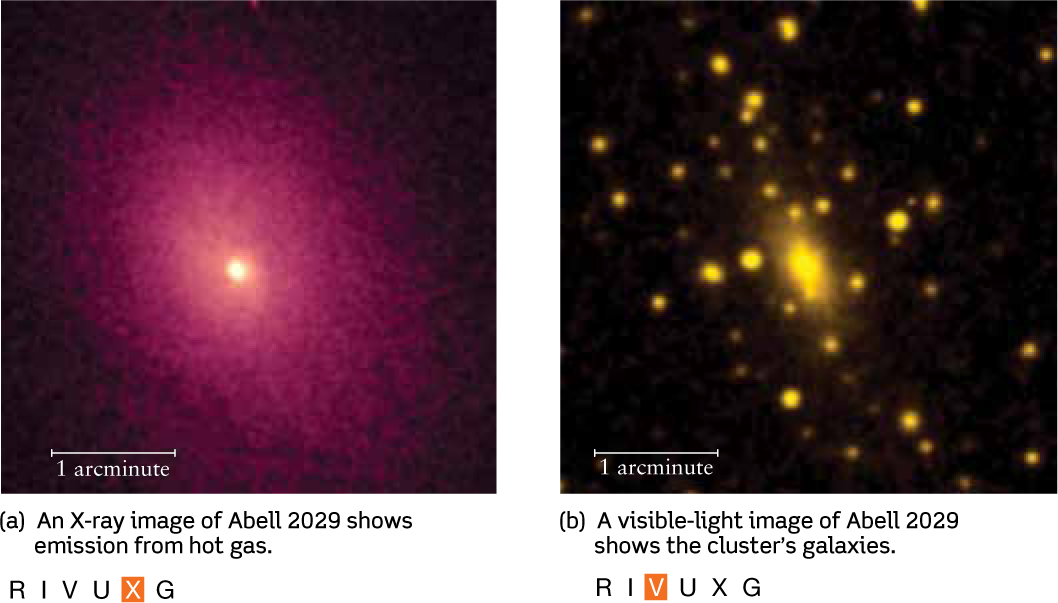
CAUTION!
Although galaxies can and do collide, it is highly unlikely that the stars from two colliding galaxies actually run into each other. The reason is that the stars within a galaxy are very widely separated from one another, with a tremendous amount of space between them.
Gentle Galactic Collisions and Starbursts
In a less violent collision or a near miss between two galaxies, the compressed interstellar gas may have more time to cool, allowing many protostars to form. Such collisions may account for starburst galaxies such as M82 (Figure 23-27), which blaze with the light of numerous newborn stars. These galaxies have bright centers surrounded by clouds of warm interstellar dust, indicating recent, vigorous star birth. Their warm dust is so abundant that starburst galaxies are among the most luminous objects in the universe at infrared wavelengths. (The right-hand image at the opening of Chapter 6 shows the infrared emission from M82’s warm dust.)
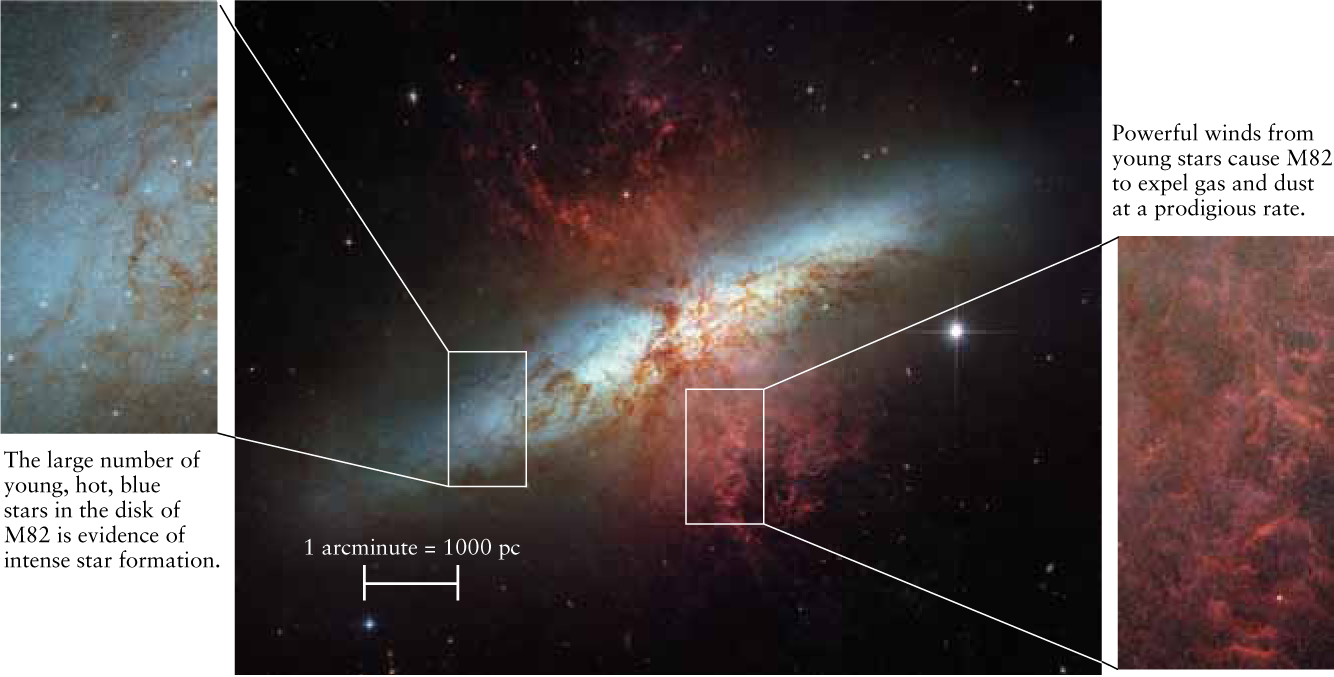
 RIVUXG
RIVUXGA Starburst Galaxy Prolific star formation is occurring at the center of the irregular galaxy M82, which lies about 3.6 Mpc (12 million ly) from Earth in the constellation Ursa Major. M82 also contains an unusual X-ray source, shown in Figure 21-16.
The starburst galaxy M82 shown in Figure 23-27 also shows the effects of strong winds from young, luminous stars. It also contains a number of luminous globular clusters. Unlike the globular clusters in our Galaxy, whose stars are about 12.5 billion years old, those in M82 are no more than 600 million years old. These young globular clusters are another sign of recent star formation.
M82 is one member of a nearby cluster of galaxies that includes the beautiful spiral galaxy M81 and a fainter elliptical companion called NGC 3077 (Figure 23-28a). Radio surveys of that region of the sky reveal enormous streams of hydrogen gas connecting the three galaxies (Figure 23-28b). The loops and twists in these streamers suggest that the three galaxies have had several close encounters over the ages. A similar stream of hydrogen gas connects our Galaxy with its second nearest neighbor, the Large Magellanic Cloud (see Figure 23-12), suggesting a history of close encounters between our Galaxy and the LMC.

687
688
CONCEPT CHECK 23-14
What energy source accounts for intergalactic gas between galaxies that is often quite hot?
Tidal Forces and Galaxy Mergers
Galaxies need not actually collide to exert strong forces on each other
Tidal forces between colliding galaxies can deform the galaxies from their original shapes, just as the tidal forces of the Moon on Earth deform the oceans and help give rise to the tides (see Section 4-8, especially Figure 4-27). The galactic deformation is so great that thousands of stars can be hurled into intergalactic space along huge, arching streams. (This same effect has stripped material away from the Canis Major Dwarf Galaxy as it orbits the Milky Way, as shown in Figure 23-20.) Supercomputer simulations of such collisions show that while some of the stars are flung far and wide, other stars slow down and the galaxies may merge.
Figure 23-29 shows one such simulation of stars (but no gas or dust). As the two galaxies pass through each other, they are severely distorted by gravitational interactions and throw out a pair of extended tails. The interaction also prevents the galaxies in the simulation from continuing on their original paths. Instead, they fall back together for a second encounter (at 625 million years). The simulated galaxies merge soon thereafter, leaving a single object. Cosmic Connections: When Galaxies Collide explores a real-life example of two galaxies that are colliding in just this way.
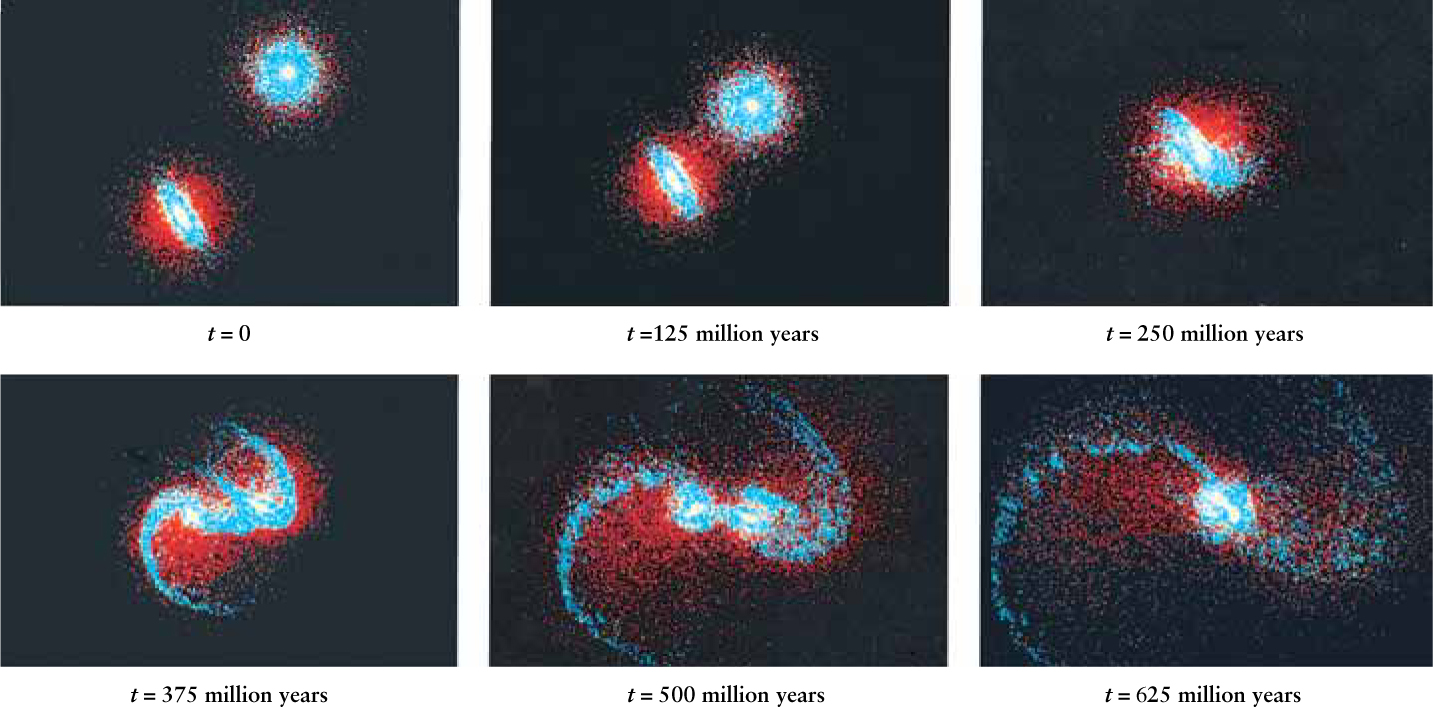
 A Simulated Collision Between Two Galaxies These frames from a supercomputer simulation show the collision and merger of two galaxies accompanied by an ejection of stars into intergalactic space. Stars in the disk of each galaxy are colored blue, while stars in their central bulges are yellow-white. Red indicates dark matter that surrounds each galaxy. The frames progress at 125-million-year intervals. Compare the bottom frames with the image of the Antennae galaxies in the Cosmic Connections: When Galaxies Collide.
A Simulated Collision Between Two Galaxies These frames from a supercomputer simulation show the collision and merger of two galaxies accompanied by an ejection of stars into intergalactic space. Stars in the disk of each galaxy are colored blue, while stars in their central bulges are yellow-white. Red indicates dark matter that surrounds each galaxy. The frames progress at 125-million-year intervals. Compare the bottom frames with the image of the Antennae galaxies in the Cosmic Connections: When Galaxies Collide.
Our own Milky Way Galaxy is expected to undergo a galactic collision like that shown in Figure 23-28. The Milky Way and the Andromeda Galaxy, shown in Figure 23-3, are actually approaching each other today fast enough to travel the Earth-Moon distance in one hour and should collide in 3.75 billion years or so (Figure 23-30). (Recall that our Sun will not become a red giant for more than 5 billion years.) During the collision, the sky will light up with a plethora of newly formed stars, followed in rapid succession by a string of supernovae.
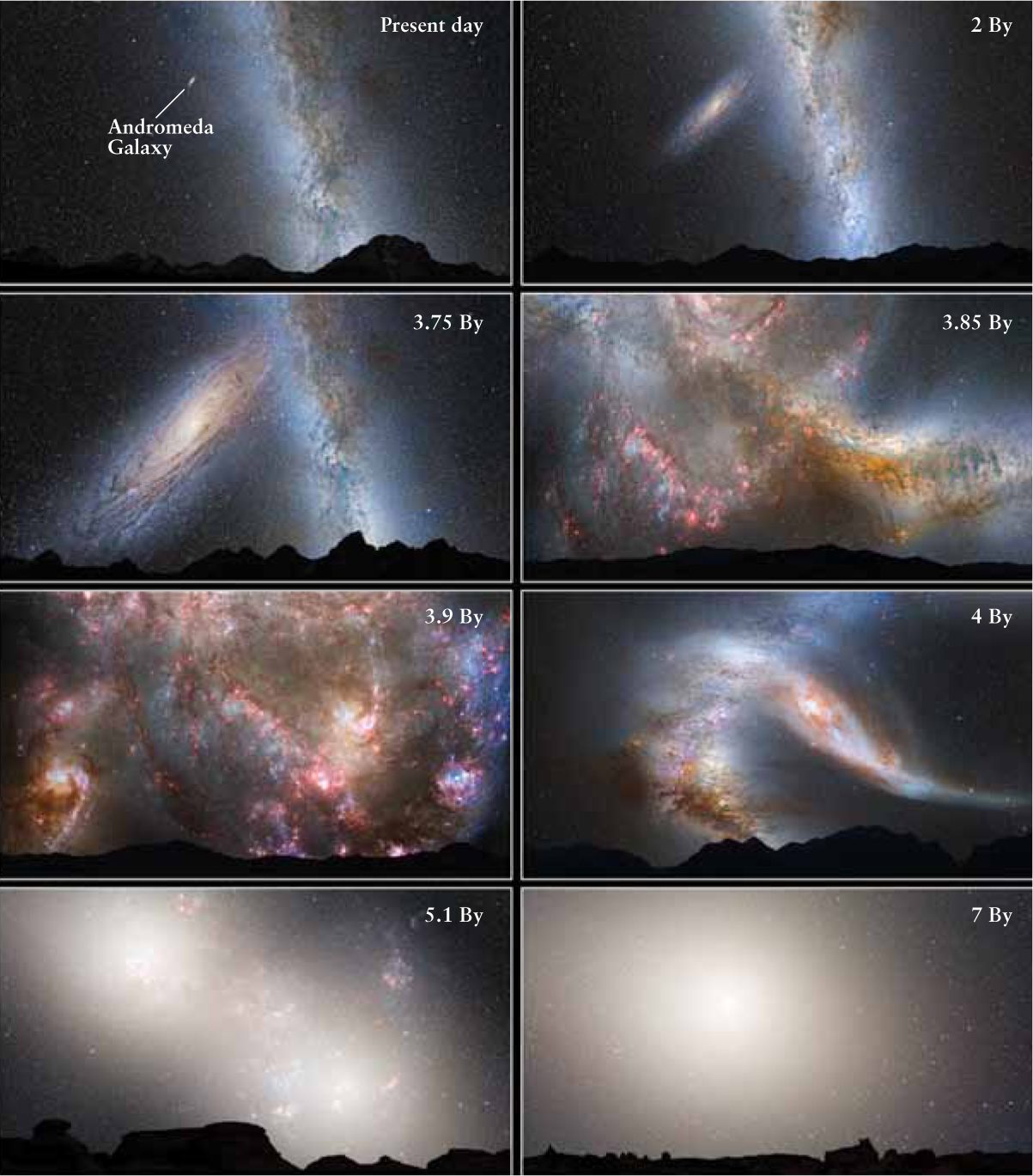
The complete merger between our Milky Way and the Andromeda Galaxy is expected to last about 2 billion years. Recall that stars are very far apart compared to their size: A galaxy scaled down in size to the United States would have stars the size of human cells, each about a football field apart. In the galactic collision, stars are not expected to hit each other and our solar system should remain intact.
 When two galaxies merge, the result is a bigger galaxy. If this new galaxy is located in a rich cluster, it may capture and devour additional galaxies, growing to enormous dimensions by galactic cannibalism. Cannibalism differs from mergers in that the galaxy that does the devouring is bigger than its “meal,” whereas merging galaxies are about the same size.
When two galaxies merge, the result is a bigger galaxy. If this new galaxy is located in a rich cluster, it may capture and devour additional galaxies, growing to enormous dimensions by galactic cannibalism. Cannibalism differs from mergers in that the galaxy that does the devouring is bigger than its “meal,” whereas merging galaxies are about the same size.
689
Many astronomers suspect that galactic cannibalism is the reason that giant ellipticals are so huge. As we have seen, giant galaxies typically occupy the centers of rich clusters. In many cases, smaller galaxies are located around these giants (see Figure 23-8 and Figure 23-21). As they pass through the extended halo of a giant elliptical, these smaller galaxies slow down and are eventually devoured by the larger galaxy.
690
COSMIC CONNECTIONS
When Galaxies Collide
 Although galaxies can collide at very high speeds by Earth standards, they are so vast that a collision can last hundreds of millions of years. Understanding what happens during a galactic collision requires ideas about tidal forces (Chapter 4), star formation (Chapter 18), and stellar evolution (Chapter 19).
Although galaxies can collide at very high speeds by Earth standards, they are so vast that a collision can last hundreds of millions of years. Understanding what happens during a galactic collision requires ideas about tidal forces (Chapter 4), star formation (Chapter 18), and stellar evolution (Chapter 19).
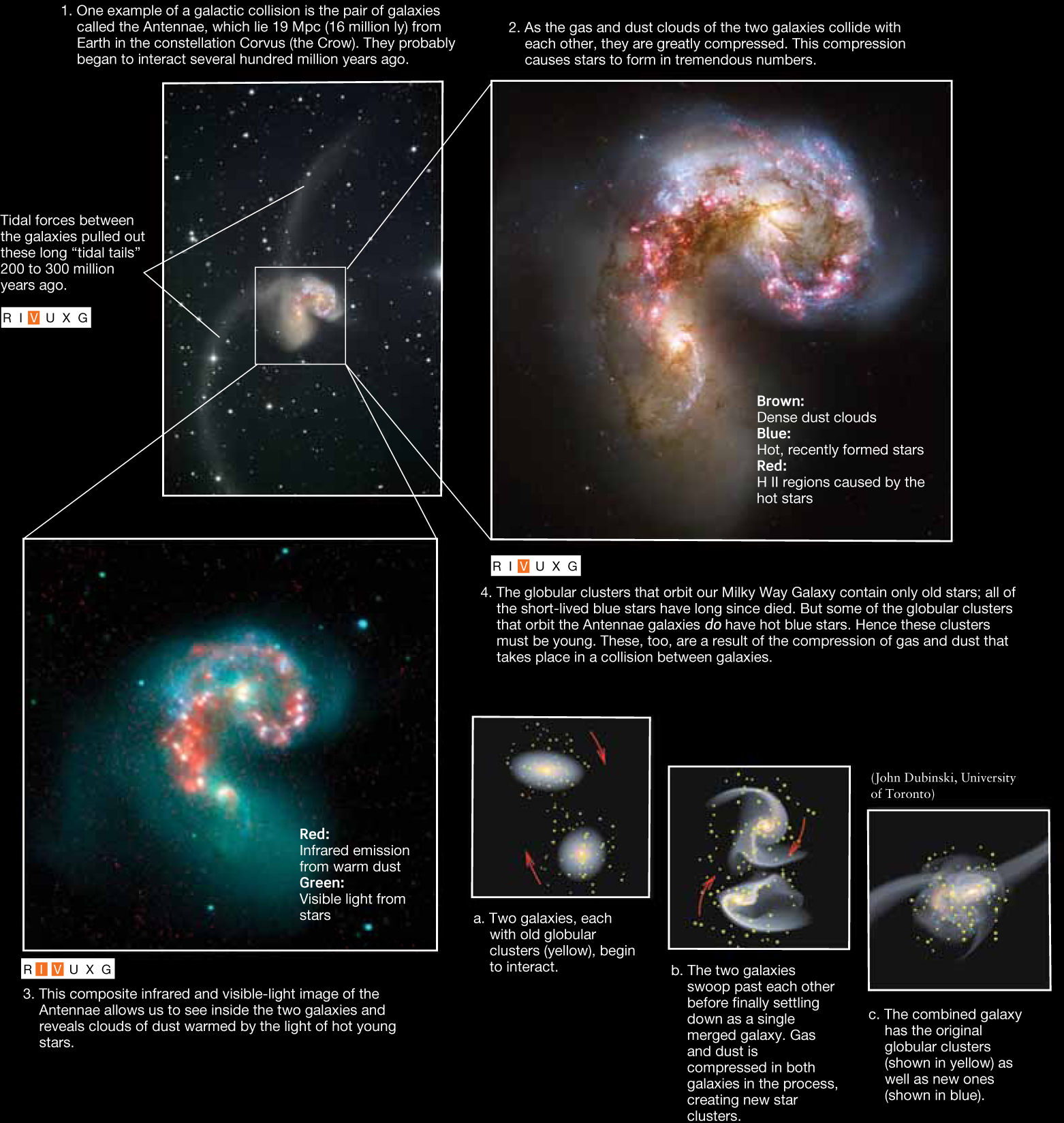
691
Galaxy Interactions and Spiral Arms
 Close encounters between galaxies provide a third way of forming spiral arms (in addition to density waves and self-propagating star formation, discussed in Section 23-5). Computer simulations clearly demonstrate that spiral arms can be created during a collision, either by drawing out long streamers of stars or by compressing clouds of interstellar gas. For example, the spiral arms of M51 (examine Figure 23-2) may have been produced by a close encounter with a second galaxy. The disruptive galaxy, NGC 5195, is now located at the end of one of the spiral arms created by the collision. The two galaxies shown in the image that opens this chapter are thought to be interacting in the same way.
Close encounters between galaxies provide a third way of forming spiral arms (in addition to density waves and self-propagating star formation, discussed in Section 23-5). Computer simulations clearly demonstrate that spiral arms can be created during a collision, either by drawing out long streamers of stars or by compressing clouds of interstellar gas. For example, the spiral arms of M51 (examine Figure 23-2) may have been produced by a close encounter with a second galaxy. The disruptive galaxy, NGC 5195, is now located at the end of one of the spiral arms created by the collision. The two galaxies shown in the image that opens this chapter are thought to be interacting in the same way.
The very fact of our existence may be intimately related to interactions between galaxies. Some astronomers argue that the spiral arms of our Milky Way Galaxy were produced by a close encounter with the Large Magellanic Cloud. As we saw in Section 22-5, spiral arms compress the interstellar medium in the Milky Way’s disk to form Population I stars like our own Sun, which have enough heavy elements to produce Earthlike planets. Thus, the chain of events that led to the formation of our Sun, our solar system, and life on our planet may have been initiated by a long-ago interaction between two galaxies.
CONCEPT CHECK 23-15
When the Milky Way Galaxy and the Andromeda Galaxy finish colliding with each other, what will be left over?